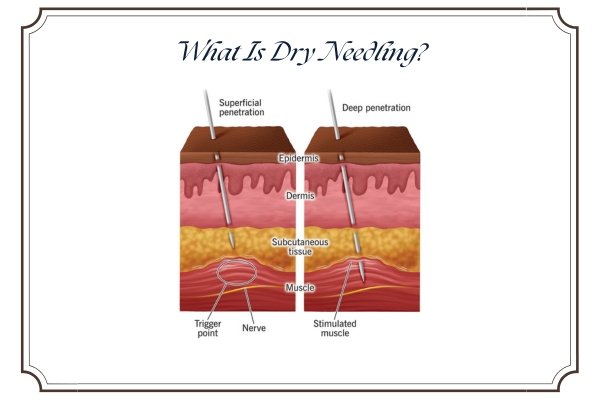Dry needling is a therapeutic technique frequently used in physiotherapy to treat musculoskeletal pain and dysfunction. While it may seem similar to acupuncture at a glance, the purpose, mechanism, and clinical rationale behind dry needling are distinct and grounded in evidence-based physiotherapy practice.
This article is designed to explain, in clear and practical terms, how dry needling works. It focuses solely on the biological process and what happens within the muscle and surrounding tissue when the technique is applied. This is not a general guide to its benefits, nor is it a comparison with other approaches. Instead, the goal is to provide clarity for those seeking to understand what dry needling does, how it interacts with the body, and why trained physiotherapists include it in treatment plans.

What Is Dry Needling?
Dry needling is a technique used by trained physiotherapists to target muscular pain and dysfunction. It involves inserting thin, sterile needles into specific areas of muscle known as trigger points or knots. These points are typically painful to touch and can refer pain to other areas of the body.
Unlike acupuncture, which is rooted in Traditional Chinese Medicine, dry needling is based on Western anatomical and neurophysiological principles. Its aim is to stimulate a healing response in the tissue, reduce tension, and improve mobility.
How Dry Needling Works in the Body
The science behind dry needling is grounded in how the body responds to muscular trigger points and the needles themselves.
When a trigger point is activated, it can disrupt normal muscle function, reduce blood flow, and increase sensitivity. By inserting a needle into this point:
- The body experiences a small, local inflammatory response.
- Blood flow increases to the area, aiding in healing.
- Neural pathways are stimulated, which can block or reduce pain signals.
- The muscle often releases tension through a reflexive twitch.
This process not only reduces discomfort but can also help restore normal movement patterns and reduce stiffness. Importantly, dry needling physio treatments are tailored to each person’s needs and may be used alongside manual therapy, exercise rehabilitation, or Home Physiotherapy services for best results.
What Are the Benefits of Dry Needling?
There are a number of recognised dry needling benefits, particularly for those experiencing:
- Muscle tightness and spasms
- Sports-related injuries and recovery
- Chronic musculoskeletal pain
- Postural imbalances
- Restricted mobility
Many people report a noticeable reduction in pain and an increase in flexibility after just one or two sessions. It’s also commonly used in conjunction with other treatments like massage, strengthening exercises, and mobility work.
Dry needling physio near me searches have surged across Australia, particularly among runners, office workers with posture-related issues, and individuals with long-term conditions like fibromyalgia or neck and shoulder tension.
Is Dry Needling Safe?
When performed by a qualified dry needling physio, the procedure is considered safe and effective. Physiotherapists in Australia undergo specific training and follow strict hygiene protocols.
Some mild after-effects are common, such as:
- Muscle soreness in the treated area
- Temporary fatigue
- Mild bruising
These typically resolve within 24 to 48 hours. Your physiotherapist will always assess your suitability before proceeding and adjust treatment based on your response.
Who Can Benefit from Dry Needling?
Dry needling can benefit a wide range of individuals, especially those who:
- Suffer from persistent muscle pain or tightness
- Are recovering from sports or overuse injuries
- Experience postural strain from desk jobs
- Have fibromyalgia or myofascial pain syndrome
- Need targeted relief in specific muscle groups
Athletes often find it useful as part of a broader recovery or performance optimisation plan. Meanwhile, office workers and manual labourers use it to ease tight muscles caused by repetitive movements or poor ergonomics.
It’s also popular in Home Physiotherapy service plans, allowing people to receive expert care without travelling to a clinic.
What Happens During a Dry Needling Session?
A typical dry needling session at clinics like Go Run Go Physio or through a home physiotherapy service will involve:
- Assessment of your symptoms and movement patterns
- Identification of relevant trigger points
- Insertion of needles into tight muscle bands
- Monitoring your response and adjusting as needed
- Post-treatment advice, including stretches or gentle exercises
Sessions usually last 30 to 45 minutes and may be combined with other hands-on physiotherapy techniques.
FAQ’s
Q1. Is dry needling painful?
Answer: You may feel a brief muscle twitch or dull ache, but most people tolerate the treatment well. Discomfort usually fades quickly.
Q2. How many sessions will I need?
Answer: This varies depending on the condition. Some clients notice improvements within 1–2 sessions, while others require ongoing care.
Q3. Can dry needling help with sports injuries?
Answer: Yes. It’s commonly used for hamstring tightness, calf pain, shoulder strain, and post-match recovery in athletes.
Q4. Can I combine dry needling with other physiotherapy treatments?
Answer: Absolutely. It’s most effective when integrated with stretching, strengthening, and manual therapy.
Q5. Is dry needling suitable for older adults?
Answer: Yes, especially for chronic muscle pain or postural issues. However, suitability is assessed case by case.
Q6. Can I request home physiotherapy with dry needling?
Answer: Yes, some providers like Go Run Go Physio offer home physiotherapy services, which may include dry needling upon assessment.
Conclusion
Dry needling offers a scientifically backed, hands-on solution for pain relief and improved muscle function. When administered by a skilled dry needling physio, it can support both short-term relief and long-term recovery.
If you’re experiencing persistent pain or limited movement, consider speaking with your physiotherapist to see if dry needling is appropriate for your situation. Whether you’re visiting a clinic or opting for a home physiotherapy service, the goal is to get you moving comfortably again.
Book your assessment today with a qualified physio near you and take the first step towards pain-free movement.

